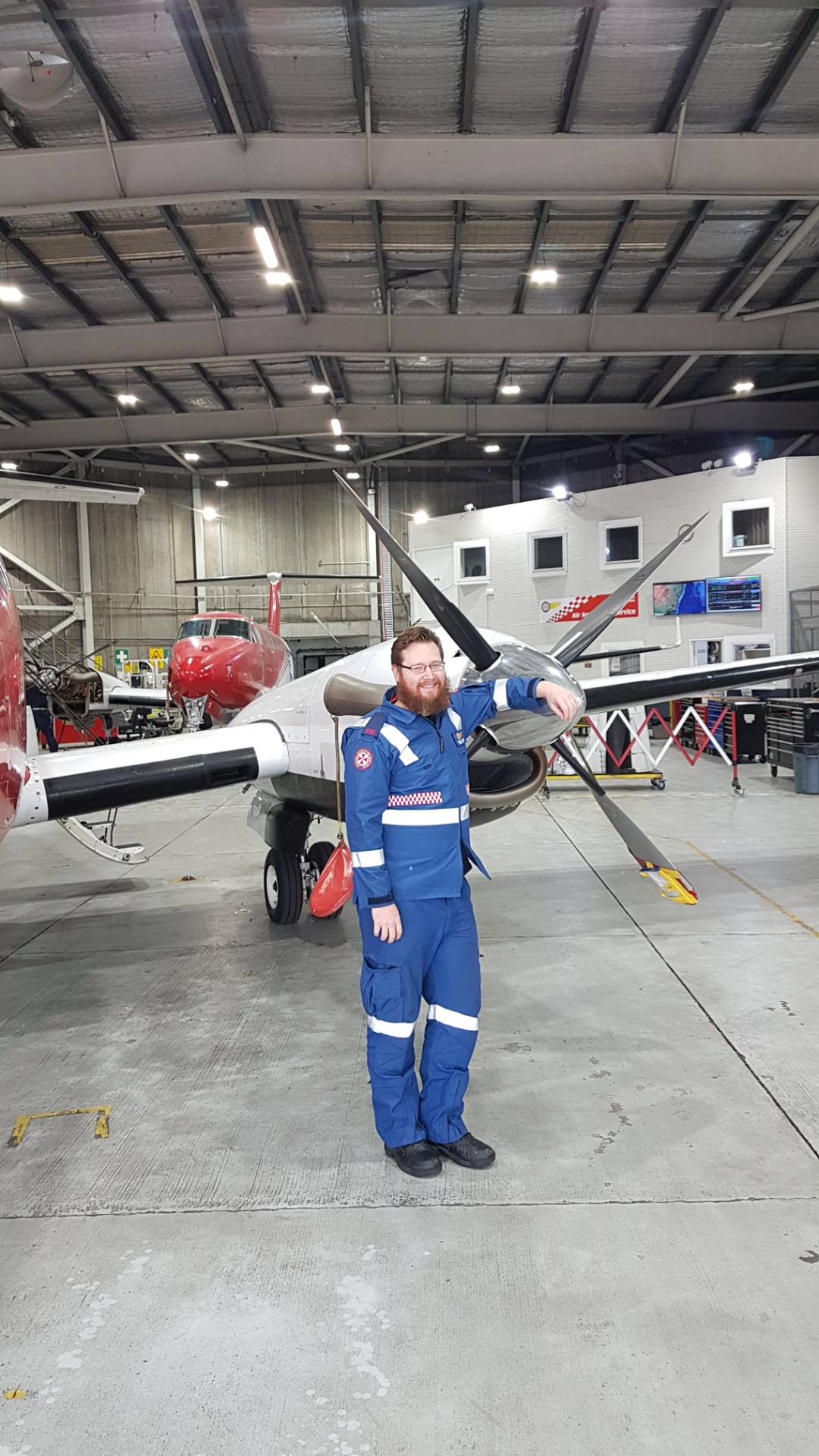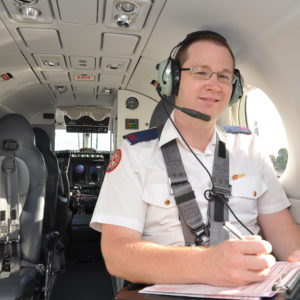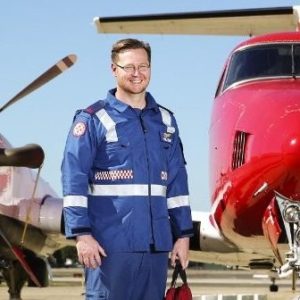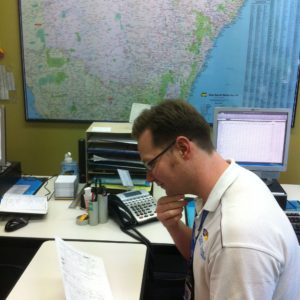Table of Contents
Pleased to have Mark write for The Nurse Break. He is currently the Flight Nurse Midwife Educator – Clinical and Aviation Safety Advisor with the NSW Air Ambulance.
He conducts the initial and ongoing education of nursing and midwifery staff in both clinical and aviation fields. This involves designing and delivering learning sessions and curriculum.
The role also includes the aviation & clinical safety and human factors portfolio. Working with leading non-technical skills experts from aviation he has developed a NTS program for pilots, flight nurses, engineers and operations officers.
Clinically, Mark is an autonomous flight nurse midwife delivering care to complex clinical cases across the lifespan.
About you
I grew up in a small town in Central Queensland where the local nurses and midwives were considered minor celebrities and were the heroes of the community. The midwife that birthed me, known as Matron, walked her dog past our house every day and my brother and I would rush out to greet her in awe.
Whenever a medical plane or aircraft was heard in the skies over the town, the entire population would jump into their cars and head out to the airport or sports ground to see the aircraft arrive. I always marvelled at the amazing people that had flown from the big city to help us when we were in need. When I was ten years old, I became acutely unwell and had to be airlifted to a larger coastal hospital with appendicitis and sepsis. It was during the ensuing protracted six-week hospital stay that I decided I wanted to become a health professional.
For some reason, I decided I wanted to be an orthopaedic surgeon which led me to be placed at the local hospital for my year 11 work experience (despite the closest orthopod being 450kms away!). It was during this time that I gained an interest in nursing. I loved that the nurses worked directly with people and supported patients from all walks of life. What I admired the most was that nurses, rather than doctors, were at the forefront of receiving and treating patients in the emergency department. It was the nurses who monitored patient’s deteriorations on the ward and called the doctor for assistance. Once I discovered that it was mainly nurses and not doctors who staffed the aeromedical plane that flew to our community I was sold! I was also privileged to observe a birth during this placement and that profoundly changed my life and led me to study midwifery.
At barely 17 (my birthday is later in the year) I started a Bachelor of Nursing at the University of Southern Queensland in Toowoomba. Being in the ‘big smoke’ was such a huge change for me and I thrived. I graduated in 2002 with Distinction and started my graduate program at St Andrews Hospital in Toowoomba. I chose this graduate program as it involved six, two months rotations in all areas of the hospital including ICU and OT. It was tough rotating every two months. I would develop confidence in one ward and before I knew it I was on another rotation. Despite this, it was probably one of the best decisions I ever made for my career. Gaining a firm grounding in a variety of medical/surgical/critical care disciplines and building the resilience required to suddenly change environments established me for the rest of my career.
Where do you currently work?
I currently work as the Flight Nurse Midwife Educator as part of the fixed-wing aeromedical operations of NSW Ambulance.
What are the main types of patients you see in your current position and what is your role in their care?
I care for diverse populations with varying conditions across the lifespan. On some missions, I may work with a critical care doctor and attend to multi-trauma or very sick medical patients in small hospitals in rural and remote NSW. This involves caring for intubated and ventilated patients with arterial lines and inotropes. A large proportion of my work involves cardiac care and neurosurgery as these services are centralised in NSW.
These patients may have external pacing wires, cardiac infusions or fluctuating GCS. I can care for sick and injured children as well as returning people home to die as part of their palliative journey. Of course, my job involves caring for many women with pregnancy complications such as preterm labour or premature rupture of the membranes along with babies who require special care nursery.
What is an example of a ‘day in the life’, and tips for others in your field?
My typical day is atypical. I will usually sign on at the base which is located at Sydney Airport in Mascot. I will contact the aeromedical control centre and they will advise me of my flight plan and patient load for that day. I will then review all the triages of the patients and begin assessing and planning for their transfer. I will contact my allocated pilot and we will conduct a pre-flight brief and go over the logistical plan together.
My flight plan may involve a high priority flight ‘out and back’ or it may involve several legs to move several patients around the state or interstate to Queensland or Victoria. We take Doctors with us on about 5% of all our flights; otherwise, it is a nurse/midwife-led service.
After reviewing my patients and making contact with the referring facilities, I will then check and pack my allocated aircraft. This requires me to be thorough and have considerable forethought as if I forget any piece of equipment I can’t just pick it up later. This gets particularly tricky when your second or third patients are children or babies. I will conduct a pre-flight check on the aircraft – it is like two emergency resuscitation bays – and complete my cabin crew duties as I also have civil aviation safety appointed duties on the aircraft. I will then either load my patients if they are coming from Sydney or otherwise depart to my first destination to meet my first patient.
I will conduct a thorough pre-flight assessment of the patient on the ground. This is really important to establish a baseline. It is important to conduct any assessments that may be difficult due to noise in flight – ie. chest/bowel sounds or foetal heart rates. I will then load the patient onto the aircraft, settle them in, give them a safety briefing and we are ready for take-off.
Once it is safe to get out of my seat in the flight I will re-assess the patient to make sure altitude and the physiology of flight is not impacting their condition. I will complete all necessary clinical interventions/care and then document my treatment. At the destination I will offload the patient and handover to the paramedics or escort the patient to hospital for handover. When I return to Sydney, I clean and restock the aircraft and complete documentation and data entry.
What is some advice/thing’s nurses can do to better prepare themselves to get a job and work in your field?
Get as much and varied experience as you can! To be a flight nurse you need to have critical care experience – I would recommend ED – but I have colleagues from ICU. You also need to be a midwife with some post-graduate experience. Any rural and remote experience is very helpful as this gets you used to working on your own and you also gain an appreciation of what it is like to be a referring clinician.
I also recommend doing as many short courses as possible – ALS, PALS, ALSO, PHTLS, TNCC, MIDUS, AREC.
Did you get any specific training/ what did that entail?
I received a comprehensive six-month orientation program when I started working as a flight nurse-midwife with NSW Ambulance. I also completed a post-graduate qualification in aviation nursing. There are now several post-graduate aeromedical degrees available to study.
What are the most rewarding parts of your area of work?
The variety of people and conditions I see. I always wanted to have a diverse practice environment like the small hospital from my home town. Such a diverse clinical scope is limited in today’s specialised world, even in smaller hospitals, and working as a flight nurse-midwife has allowed me to become a ‘specialist generalist’ nurse and midwife. I love being able to contribute to a service that links people from remote regions to city-based services. I truly understand how much a service like this means to people in the bush and I appreciate that I would most likely not be alive if it wasn’t for a similar service. I would also be lying if I didn’t say I love flying and aviation – I am a certified Avgeek.
What are the most difficult parts of your area of work?
Flying and weather! Turbulence, storms, snow, heat, wind and rain all make for loading patients on open tarmacs not so fun. Turbulence, whilst perfectly safe, can still be pretty scary in a small aircraft – sometimes you have to put on a brave face to reassure others.
Flying is also very draining and fatiguing – especially on the night shift when you would much rather be in the stability of a hospital. The stressors of flight are pretty hard on the body and I really struggled with fatigue for the first six months of my job. I had previously been working 12 hours shifts in a busy ED without feeling too tired. But when I started flying I was exhausted but I adapted after a while.
What do you carry on you during a shift?
I have a small bag with reference materials, toothpaste, deodorant and spare underwear! I never know if I may end up overnighting somewhere. I have to be very prepared with my food and water – as there are limited places to buy sustenance in rural NSW! Everything else is in my aircraft – it truly is a fully functioning resuscitation bay.
How do you destress after a shift and self-care?
Swimming is my saviour. I also reflect on my practice on the way home and make a commitment that I leave work in my car.
What different areas of nursing have you worked in?
General medical, palliative care, surgical, surgical HDU/ICU, rural and remote, A&E, aeromedical.
I have also worked as a midwife both in large and rural hospitals.
Can you share some night shift tips?
Sleep as much as you can pre-shift – even if it just for a short nap.
Sleep in a cold dark room and have a pre-sleep routine that you stick to. If you are lying there awake, tossing and turning, get up, stay in low light and read.
Having a big meal of carbs before sleeping is a good idea.
Sleep comes in waves – catch them when you feel them.
Limit your use of electronic devices – the blue light is so bad for sleep initiation. I always swap the nocturnal settings on my phone around during night shift so I get the dull yellow light in the mornings.
To recover – I try and get as much sunlight as I can (even if overcast) after a good nap on day 1. Sunlight is the best re-setter.
What would you do if you weren’t a nurse?
I can’t imagine not being a nurse and a midwife.
What’s in your lunch box!
High protein low carb food that doesn’t require much refrigeration as there is no refrigeration on the aircraft. Although I have a little supply of chocolate for emergencies!
What is one piece of advice for students you would give who are worried about starting a graduate year?
It is going to be hard at times. Your non-technical skills will be way more important than any of your technical skills. Be kind to yourself – you will need lots of self-compassion. Never be afraid to ask questions, especially the silly ones. Don’t be afraid to ask for help. Identify other nurses who will be kind and helpful to you. They are out there – even on days when you think they aren’t! Get a mentor and keep them for life. Have as much fun as you can and believe it or not, but you will look back on these days as some of your best.
What is it like being a male in the nursing profession?
I really dislike the term ‘male nurse’. I am a nurse – pure and simple. The definition of a nurse is not gender-specific and adding a male to it only reinforces social conditioning. Being singled out as a male nurse also diminishes the great work that the female majority of the profession does daily. Being a male in nursing makes you more visible. I was only one of a handful of males in my class at university. I think maybe only two of us graduated in the end. I never experienced any discrimination or issues being a male. If anything, my male privilege probably advanced my career in the early years.
Being a man in a female-dominated occupation has taught me more empathy and compassion than I would have ever experienced elsewhere. Amazing things happen when you are forced to examine your own privilege when you find yourself in the minority. I can’t recall any patient ever having issues with me being male. Being a male in midwifery is slightly different and that is another story.
I have also witnessed first-hand the effects of the patriarchy – something only nursing would have allowed me to see. I have had the best female bosses all my career which has given me a greater understanding of the feminist debate. I have gained huge respect and admiration for the many, many, many female leaders that face so much adversity in nursing leadership because of their gender. I have seen other male health professionals treating me differently than my female counterparts and I was often assumed to be in charge despite being the most junior nurse on the floor.
My advice for other men in nursing? Is to just do it! Be prepared to critically reflect and have your perspective on the world changed – rapidly and uncomfortable at times. Don’t be afraid of the stereotypes that men can’t be seen as caring, nurturing, and supportive. A large proportion of the role of nursing is emotional support and crying. Be brave and show that men can do this. Women don’t have the monopoly on being nurturers and healers and in fact you will soon learn these certainly aren’t gender-specific inborn traits.
Conluding thoughts
Flight Nursing and Midwifery is an awesome job. It allows me to practice autonomously and at an advanced unsupervised level. This requires some discipline and I must ensure the currency of my diverse practice. Every day is different and I love working with a large team of professionals I never thought I would work with professions such as pilots and engineers. They are all part of the team and truly care for our patients.
Flight Nurses Australia is also a great organisation that I am a member of. They hold an amazing annual conference which provides invaluable networking amongst the industry. I wish I had joined them as a student and linked up with a mentor to help guide me into the industry. This is their website and it provides great advice on how to become a flight nurse midwife: https://flightnursesaustralia.com.au/how-to-be-a-flight-nurse/
For more flight nursing content check out here









You must be logged in to post a comment.